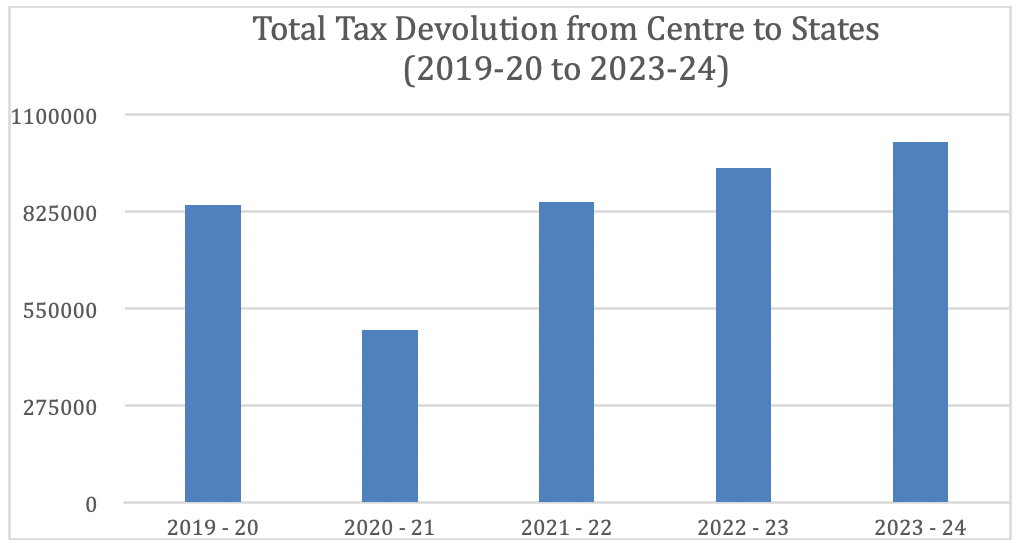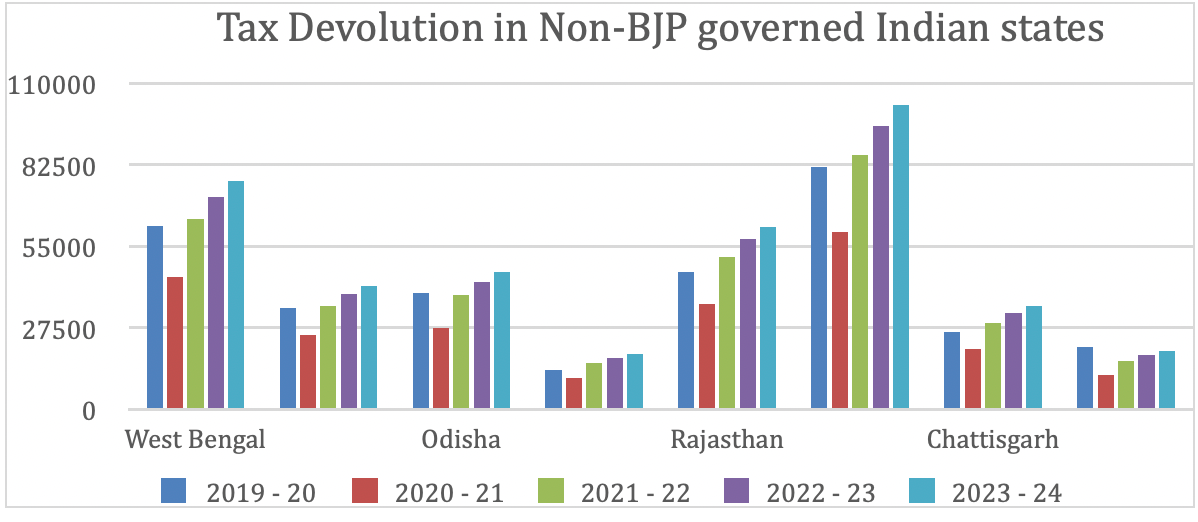Behind Union Govt’s Rhetoric of Higher Tax Devolution for States Lies a Silent Fiscal Crisis
In a recent tweet, the Ministry of Finance announced that the Union government disbursed Rs 1,18,280 crore as the third instalment of tax devolution to state governments in June, as against the normal monthly devolution of Rs 59,140 crore. Monthly figures of Centre-state disbursements may often give misleading signals. In recent years, the fiscal capacity, and discretion of the Union government in collecting and disbursing promised tax revenue to states has remained more volatile.
The research team at InfoSphere, Centre for New Economics Studies (CNES), O.P. Jindal Global University, recently completed a study observing the Centre-state fiscal relationship more closely. A more detailed version of our findings was earlier discussed here. The factsheet shared by the finance ministry triggered a parallel deep-dive by the team investigating the available data (from 2019 onwards) on tax devolution-share of funds from the Union government to all state governments, drawn from government sources.
Some observations follow.

Figure 1. Source: Author's calculations (InfoSphere, CNES)
Figure 1 presents the overall net tax devolution proceeds (in Rs crore) from 2019 onwards transferred by the Union government to all state governments. UTs are excluded from this list.

Figure 2. Source: Author's calculations (InfoSphere, CNES)
Figure 2 (above) gives a macro-trend of tax devolution from the Union government on a year-to-year basis. This is a function of the accrued fiscal revenue capacity of the Union government over the last few years. FY 2020-21, the first year of the COVID-19 pandemic, was tough for the fiscal purse of the government as a whole and as a result, saw the lowest tax devolution level from the Centre to the states.
This forced states to borrow extensively to cover healthcare and other pandemic-induced costs from these ‘borrowed resources’. As a result, their fiscal deficit-debt levels rose. As argued earlier, there has been increasing evidence of the Union government arbitrarily squeezing the borrowing power of certain states, currently governed by opposition parties. Most state finance ministers have put this on record.
Figures 3 and 4 below provide a ‘select’ look at the Centre to State tax devolution levels for a few opposition-governed vs BJP-governed states (refer here for source).

Figure 3. Source: Author's calculations (InfoSphere, CNES)

Figure 4. Source: Author's calculations (InfoSphere, CNES)
States like Bihar and Uttar Pradesh still get most of the tax-devolution share from the Union government – largely because of their spatial, demographic, and socio-economic needs.
While states like Haryana, Punjab, and Kerala haven’t seen any critical growth in their tax-devolution share over the last five years. It is pertinent to note how each of these states has also seen its worst fiscal position scenario – accompanied by a decline in GSDP levels over these years too (worsening since the pandemic), which warranted a more interventionist, counter-cyclical fiscal support from the Union government.
Also, states like Tamil Nadu, Chhattisgarh, Himachal Pradesh, and Uttarakhand, haven’t seen any drastic shift in their net-devolution share too. This is despite states like Tamil Nadu, which have a strong GSDP position, contributing a lot more to the Union government’s tax revenue share.
A lack of vision in the medium to long-term fiscal-policy approach, from the Union government’s tax-based disbursements has therefore inadequately addressed this challenge/question: What role has the Union government, which, by law and constitutional power, is assigned more fiscal capacity and discretion to raise and spend tax-based revenue resources, played in supporting states through spending?
What we see in these trends are three broader, consequential categorical imperatives:
- the Union government has merely maintained status-quo when it comes to giving states ‘what they need’. It hasn't transferred more or envisioned to transfer more tax revenue with the aim to enable a given state’s own welfare or growth needs/revenue requirements. The available data on transfers for both BJP-governed and non-BJP-governed states tell a tragic tale of lopsided growth patterns evident across states, which is more of a continuum from the past, than seeing/realising change. This raises a more troubling question (for point 2).
- what this says is the Union government under the Modi administration (since the last few years, read 2019 onwards from our data) has increasingly seen a gradual erosion in its fiscal capacity and will to support states which need more revenue for growth and welfare requirements. This fact subsequently has little to do with the political parties governing the states, but over time, the larger issue has become more aligned with the Union government’s own poor revenue collection capacity (i.e. failing to collect the revenue that the Union government projects in its own Union Budget estimate).
- poor quality government data makes it extremely difficult for anyone to effectively analyse the potential gains/losses being made from the allocated tax devolution proceeds shared by the Union government for states over the last few years. See the RBI Handbook of Statistics for data on GSDP (2008-09 is the last year mentioned), or for poverty. The current administration, it seems, has done everything in its power to not even collect ‘good’ data which can help recognise fiscal challenges/potentials, to strengthen policy for the long-term good.
This is a marked sign of a fiscally weak and insecure government that is content to project empty riddles of economic optimism built merely around rhetorical hope, pasting ‘India Shining' data on relative comparisons of good growth performance (made with countries industrially far more advanced and at a higher order of development), but underneath its own core, India suffers from a silent fiscal crisis and under poor macroeconomic fundamentals. These indicate an economy moving towards a state of permanent decline, sourced from structural weakness, in which any Union government will be able to do (fiscally) very little for states even if they want to do more (assuming there is a willingness to do so).
This article reflects the extensive research work, and statistical inputs offered by InfoSphere Team at CNES, O.P. Jindal Global University. To review InfoSphere’s work, please see its website here.
Deepanshu Mohan is an associate professor of economics and director at the Centre for New Economics Studies at Jindal School of Liberal Arts and Humanities, OP Jindal Global.
This article went live on June fifteenth, two thousand twenty three, at zero minutes past eight in the morning.The Wire is now on WhatsApp. Follow our channel for sharp analysis and opinions on the latest developments.




